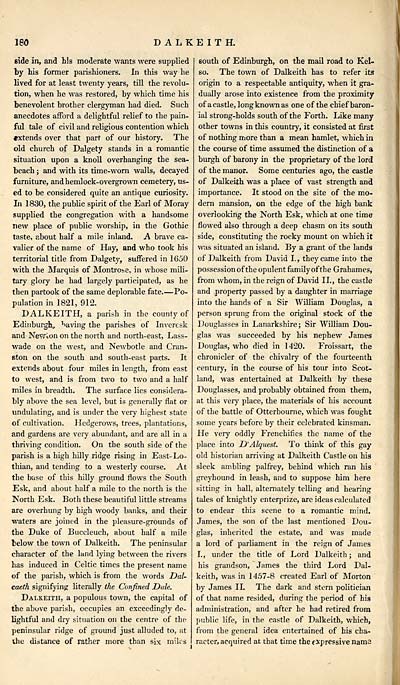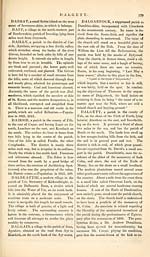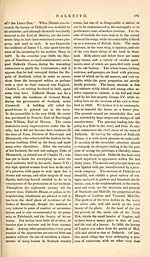Gazetteer of Scotland > Volume 1
(208) Page 180
Download files
Complete book:
Individual page:
Thumbnail gallery: Grid view | List view

180
DALKEITH.
side in, and his moderate wants were supplied
by his former parishioners. In this way he
lived for at least twenty years, till the revolu-
tion, when he was restored, by which time his
benevolent brother clergyman had died. Such
anecdotes afford a delightful relief to the pain-
ful tale of civil and religious contention which
extends over that part of our history. The
old church of Dalgety stands in a romantic
situation upon a knoll overhanging the sea-
beach ; and with its time-worn walls, decayed
furniture, and hemlock-overgrown cemetery, us-
ed to be considered quite an antique curiosity.
In 1830, the public spirit of the Earl of Moray
supplied the congregation with a handsome
new place of public worship, in the Gothic
taste, about half a mile inland. A brave ca-
valier of the name of Hay, and who took his
territorial title from Dalgety, suffered in 1650
with the Marquis of Montrose, in whose mili-
tary glory he had largely participated, as he
then partook of the same deplorable fate Po-
pulation in 1821, 912.
DALKEITH, a parish in the county of
Edinburgh, having the parishes of Inveresk
and Newlon on the north and north-east, Lass-
wade on the west, and Newbotle and Cran-
ston on the south and south-east parts. It
extends about four miles in length, from east
to west, and is from two to two and a half
miles in breadth. The surface lies considera-
bly above the sea level, but is generally flat or
undulating, and is under the very highest state
of cultivation. Hedgerows, trees, plantations,
and gardens are very abundant, and are all in a
thriving condition. On tbe south side of the
parish is a high hilly ridge rising in East-Lo-
thian, and tending to a westerly course. At
the base of this hilly ground flows the South
Esk, and about half a mile to the north is the
North Esk. Both these beautiful little streams
are overhung by high woody banks, and their
waters are joined in the pleasure-grounds of
the Duke of Buccleuch, about half a mile
below the town of Dalkeith. The peninsular
character of the land lying between the rivers
has induced in Celtic times the present name
of the parish, which is from the words Dal-
caeth signifying literally the Confined Dale.
Dalkeith, a populous town, the capital of
the above parish, occupies an exceedingly de-
lightful and dry situation on the centre of the
peninsidar ridge of ground just alluded to, at
ihe distance of rather more than six miles
south of Edinburgh, on the mail road to Kel-
so. The town of Dalkeith has to refer its
origin to a respectable antiquity, when it gra-
dually arose into existence from the proximity
of a castle, long known as one of the chief baron-
ial strong-holds south of the Forth. Like many
other towns in this country, it consisted at first
of nothing more than a mean hamlet, which in
the course of time assumed the distinction of a
burgh of barony in the proprietary of the lord
of the manor. Some centuries ago, the castle
of Dalkeith was a place of vast strength and
importance. It stood on the site of the mo-
dern mansion, on the edge of the high bank
overlooking the North Esk, which at one time
flowed also through a deep chasm on its south
side, constituting the rocky mount on which it
was situated an island. By a grant of the lands
of Dalkeith from David I., they came into the
possession of the opulent family of the Grahames,
from whom, in the reign of David II. , the castle
and property passed by a daughter in marriage
into the hands of a Sir William Douglas, a
person sprung from the original stock of the
Douglasses in Lanarkshire; Sir William Dou-
glas was succeeded by his nephew James
Douglas, who died in 1420. Froissart, the
chronicler of the chivalry of the fourteenth
century, in the course of his tour into Scot-
land, was entertained at Dalkeith by these
Douglasses, and probably obtained from them,
at this very place, the materials of his account
of the battle of Otterbourne, which was fought
some years before by their celebrated kinsman.
He very oddly Frenchifies the name of the
place into D'Alquest. To think of this gay
old historian arriving at Dalkeith Castle on his
sleek ambling palfrey, behind which ran his
greyhound in leash, and to suppose him here
sitting in hall, alternately telling and hearing
tales of knightly enterprize, are ideas calculated
to endear this scene to a romantic mind.
James, the son of the last mentioned Dou-
glas, inherited the estate, and was made
a lord of parliament in the reign of James
I., under the title of Lord Dalkeith; and
his grandson, James the third Lord Dal-
keith, was in 1457-8 created Earl of Morton
by James II. The dark and stern politician
of that name resided, during the period of his
administration, and after he had retired from
public life, in the castle of Dalkeith, which,
from the general idea entertained of his cha-
racter, acquired at that time the expressive nama
DALKEITH.
side in, and his moderate wants were supplied
by his former parishioners. In this way he
lived for at least twenty years, till the revolu-
tion, when he was restored, by which time his
benevolent brother clergyman had died. Such
anecdotes afford a delightful relief to the pain-
ful tale of civil and religious contention which
extends over that part of our history. The
old church of Dalgety stands in a romantic
situation upon a knoll overhanging the sea-
beach ; and with its time-worn walls, decayed
furniture, and hemlock-overgrown cemetery, us-
ed to be considered quite an antique curiosity.
In 1830, the public spirit of the Earl of Moray
supplied the congregation with a handsome
new place of public worship, in the Gothic
taste, about half a mile inland. A brave ca-
valier of the name of Hay, and who took his
territorial title from Dalgety, suffered in 1650
with the Marquis of Montrose, in whose mili-
tary glory he had largely participated, as he
then partook of the same deplorable fate Po-
pulation in 1821, 912.
DALKEITH, a parish in the county of
Edinburgh, having the parishes of Inveresk
and Newlon on the north and north-east, Lass-
wade on the west, and Newbotle and Cran-
ston on the south and south-east parts. It
extends about four miles in length, from east
to west, and is from two to two and a half
miles in breadth. The surface lies considera-
bly above the sea level, but is generally flat or
undulating, and is under the very highest state
of cultivation. Hedgerows, trees, plantations,
and gardens are very abundant, and are all in a
thriving condition. On tbe south side of the
parish is a high hilly ridge rising in East-Lo-
thian, and tending to a westerly course. At
the base of this hilly ground flows the South
Esk, and about half a mile to the north is the
North Esk. Both these beautiful little streams
are overhung by high woody banks, and their
waters are joined in the pleasure-grounds of
the Duke of Buccleuch, about half a mile
below the town of Dalkeith. The peninsular
character of the land lying between the rivers
has induced in Celtic times the present name
of the parish, which is from the words Dal-
caeth signifying literally the Confined Dale.
Dalkeith, a populous town, the capital of
the above parish, occupies an exceedingly de-
lightful and dry situation on the centre of the
peninsidar ridge of ground just alluded to, at
ihe distance of rather more than six miles
south of Edinburgh, on the mail road to Kel-
so. The town of Dalkeith has to refer its
origin to a respectable antiquity, when it gra-
dually arose into existence from the proximity
of a castle, long known as one of the chief baron-
ial strong-holds south of the Forth. Like many
other towns in this country, it consisted at first
of nothing more than a mean hamlet, which in
the course of time assumed the distinction of a
burgh of barony in the proprietary of the lord
of the manor. Some centuries ago, the castle
of Dalkeith was a place of vast strength and
importance. It stood on the site of the mo-
dern mansion, on the edge of the high bank
overlooking the North Esk, which at one time
flowed also through a deep chasm on its south
side, constituting the rocky mount on which it
was situated an island. By a grant of the lands
of Dalkeith from David I., they came into the
possession of the opulent family of the Grahames,
from whom, in the reign of David II. , the castle
and property passed by a daughter in marriage
into the hands of a Sir William Douglas, a
person sprung from the original stock of the
Douglasses in Lanarkshire; Sir William Dou-
glas was succeeded by his nephew James
Douglas, who died in 1420. Froissart, the
chronicler of the chivalry of the fourteenth
century, in the course of his tour into Scot-
land, was entertained at Dalkeith by these
Douglasses, and probably obtained from them,
at this very place, the materials of his account
of the battle of Otterbourne, which was fought
some years before by their celebrated kinsman.
He very oddly Frenchifies the name of the
place into D'Alquest. To think of this gay
old historian arriving at Dalkeith Castle on his
sleek ambling palfrey, behind which ran his
greyhound in leash, and to suppose him here
sitting in hall, alternately telling and hearing
tales of knightly enterprize, are ideas calculated
to endear this scene to a romantic mind.
James, the son of the last mentioned Dou-
glas, inherited the estate, and was made
a lord of parliament in the reign of James
I., under the title of Lord Dalkeith; and
his grandson, James the third Lord Dal-
keith, was in 1457-8 created Earl of Morton
by James II. The dark and stern politician
of that name resided, during the period of his
administration, and after he had retired from
public life, in the castle of Dalkeith, which,
from the general idea entertained of his cha-
racter, acquired at that time the expressive nama
Set display mode to: Large image | Transcription
Images and transcriptions on this page, including medium image downloads, may be used under the Creative Commons Attribution 4.0 International Licence unless otherwise stated. ![]()
| Gazetteers of Scotland, 1803-1901 > Gazetteer of Scotland > Volume 1 > (208) Page 180 |
|---|
| Permanent URL | https://digital.nls.uk/97426858 |
|---|
| Description | Volume I: Abbey to Glenartney. |
|---|---|
| Attribution and copyright: |
|
| Description | By Robert Chambers and William Chambers. Glasgow: Blackie & Son, 1838. 2 volumes. |
|---|---|
| Shelfmark | NF.1461.g.7 |
| Additional NLS resources: | |

